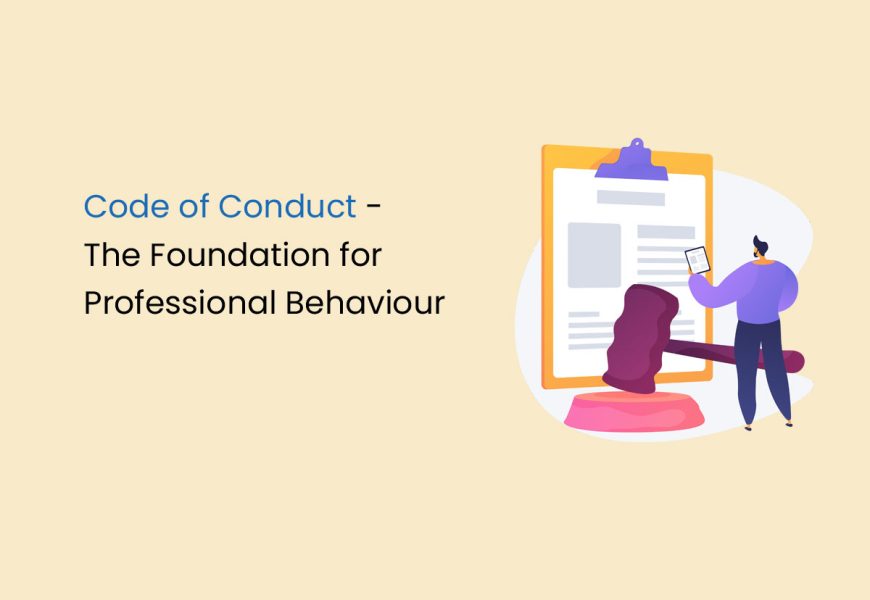Organisations need a solid ethical foundation—a code of conduct guides responsible and moral behaviour. A code of conduct is a set of guidelines a company develops to protect its interests and inform its employees of its expectations. Both small and large businesses are required to prepare a document that contains vital information about employee expectations.
This blog will explore the Code of Conduct, its significance, elements, and impact on work culture.
What is Code of Conduct?
The code of conduct is the values, rules, standards, and principles outlining employee behaviour within an organisation. The code of conduct provides guidelines for employees and lays the foundation for other company policies. It is not a contract or a replacement for policies.
A code of conduct is essential for any organisation to maintain a healthy work environment. It should be relevant to the company and its employees and align with its values, mission, vision, and principles. When developing a code of conduct, the company should consider its location and industry and take input from all areas, especially the HR department.
Elements of a Code of Conduct
The elements of the code of conduct are as follows:
- Ethical Guidelines: It is crucial to have a set of well-defined ethical principles in place to ensure that decision-making is guided by integrity, fairness, and responsibility. These principles act as a moral compass for individuals and organisations, helping them to make sound judgments and choices that align with their values and beliefs.
- Professionalism: To promote a positive work environment, define expectations for communication, dress code, and professionalism. Foster respect and inclusivity for all employees, regardless of background or identity. Create a supportive culture by establishing clear guidelines and mutual understanding.
- Confidentiality: Protocols for handling sensitive information are vital for the privacy and confidentiality of individuals. It’s important to respect privacy and maintain confidentiality to prevent unauthorised access or disclosure of sensitive information.
- Anti-Discrimination and Harassment: Communicating the organisation’s zero-tolerance policy against discrimination is essential. It outlines the procedures for reporting and addressing discrimination. Employees should be educated on identifying and preventing harassment. Channels for reporting harassment should be established, and the consequences for perpetrators should be clearly stated. Additionally, it is vital to ensure compliance with legal and regulatory standards.
- Compliance: The organisation should comply with all relevant legal standards and industry regulations. They should establish clear procedures for reporting instances of non-compliance and offer protection and support to whistleblowers. They should also conduct regular compliance audits and update our Code to comply with evolving legal and regulatory landscapes.
Significance of Code of Conduct
A code of conduct helps a company:
- Demonstrating Company Values: The company’s code of conduct outlines prohibited behaviours and reflects its values. Posting the code to the public lets people learn about the company’s ethics, morals, and values.
- Guiding Behaviour in the Workplace: the code presents clear expectations for employees, making it easier to create a healthy work environment where everyone behaves professionally.
- Adherence to the Law: A code of conduct primarily deals with inappropriate behaviour, including workplace harassment. When employees comply with the company’s policies and conduct themselves within legal boundaries, it ensures the safety of everyone in the workplace, shielding them from harm.
- Increasing Employee Morale: It helps employers retain and attract more employees. A code of conduct reinforces equal and fair treatment of employees to establish a more positive workplace environment.
- Measuring Employee Success: The rules the code sets can help employers measure an employee’s success. If they notice an employee isn’t the code, the employer can pinpoint precisely how the employee can improve.
- Making Ethical Decisions: A code of conduct embodies a company’s values and goals. It provides a framework for ethical decision-making, encouraging employees to act in the best interest of the company and others.
Benefits of a Code of Conduct
Implementing a code of conduct has the following benefits:
- It serves as a guide for creating a safe and healthy workplace, reducing legal risks, and building trust between management and staff.
- The code of conduct guides the rules, policies, and procedures that must be followed in any situation involving employee behaviour.
- It prevents misunderstandings that can lead to disciplinary action or termination.
- An effective code of conduct can help employees engage in the company’s mission by providing clear rules and compliance initiatives.
- The code of conduct assures employees that their voices will be heard and provides them with a way to report any misconduct or violations of the code.
- It can be printed and displayed in offices throughout the company to make it visible to employees.
- A code of conduct can be used to change or improve the workplace.
- It is not just for internal use but can also help customers understand the behaviour they should expect from employees.
- Creating a standard code of ethics and values for all employees can reduce discrimination, harassment, and other such behaviour within the company.
- It can also give customers a sense of security, knowing that their rights are protected by clear rules that apply to everyone.
Code of Conduct vs Policies
A code of conduct sets out the values of an organisation and informs employees of expected behaviour. Policies address specific situations such as discrimination and sexual harassment.
Code of Ethics and Code of Conduct
A code of conduct and a code of ethics are often confused, but they are different. A code of ethics provides guidelines on ethical obligations towards the employer, customers, business partners, and society. It is broader and guides the type of behaviour and acceptable decisions in an organisation.
On the other hand, a code of conduct is more specific and focuses on individuals’ explicit acceptable and unacceptable behaviour. It helps to define the rules of behaviour in a workplace or organisation.
Aspects a Code of Conduct Addresses
The aspects of a workplace that a code of conduct addresses are as follows:
- The work environment
- Any conflicts of interest
- Company assets and resources
- Anti-bribery and corruption
- Attendance and punctuality
- Communication
- Misconduct
- Authority
- Leave and absence without notice
- Harassment, bullying and abuse
- Discrimination
- Personal device use
- The dress code
- Substance abuse
- Internet use
- Plagiarism
Code of Conduct Best Practices
The best practices when drafting a code of conduct are as follows:
- Avoid technical jargon and write with the reader in mind.
- Consider all the details that you want to include in the code.
- Make sure it is comprehensive and can answer any questions that may arise.
- Ensure it is accessible to all employees and other stakeholders.
- Design the document to match the company’s branding and ensure it is understandable.
Benefits of a Code of Conduct for Employees
The benefits of a code of conduct to employees are as follows:
- It’s a tool for setting clear expectations between employees and the organisation.
- It promotes mutual understanding among staff by providing clear expectations and responsibilities through illustrative examples.
- The code establishes clear boundaries to promote a positive work environment by defining acceptable and unacceptable behaviour.
- It emphasises ethical business conduct and prevents discriminative language, fostering an inclusive workplace culture.
- It clarifies what is considered misconduct, setting a standard for professional behaviour within the organisation.
- The code outlines the company’s expectations regarding business ethics, making them explicit and easily understood by all employees.
- Employees can better understand the company’s ethical standards by following the guidelines outlined in the code.
4 Code of Conduct Examples
Here are some examples of code of conduct:
Example 1: Use of Technology
During work hours, employees can only use personal technology during breaks. For social media posts related to the company, employees must state they are posting on their behalf and be respectful. Concerns must be addressed with their manager or HR, not online.
Example 2: Plagiarism
We value giving credit where it’s due. Employees must only take credit for their original work and cite external resources. Our company follows a unique style guide for citations. Refer to the Handbook on our website for guidance.
Example 3: Dress Code
Our relaxed dress code allows jeans, T-shirts, and sweatshirts, but business casual attire is also acceptable. Avoid inappropriate clothing, and in case of client or investor visits, we’ll inform you of dress code changes beforehand. Business casual attire includes nice slacks, skirts, dresses, button-down shirts, blouses, and closed-toe shoes.
Example 4: Employee Break Policies
Employees have a 30-minute paid lunch break during their shift, which can be extended to an hour, but they must clock out for 30 minutes. For shifts over 8 hours, there are two 15-minute breaks. Employees should take one break a few hours before lunch and the other after. To ensure customer service is not affected, employees should coordinate break times. Any additional breaks must be approved by their manager.
Breach of Conduct
When an employee breaches the code of conduct, an investigation must occur, followed by implementing appropriate sanctions. The policy should clearly define what constitutes misconduct and the corresponding sanctions imposed in case of a breach. Additionally, the policy must include information on how employees can appeal code of conduct sanctions.
Conclusion
A well-implemented Code of Conduct is crucial for creating a positive work environment. Prioritising ethics can reduce risks, build trust, and attract top talent in today’s competitive market. As technology advances, our commitment to ethical practices must also evolve. The Code of Conduct is essential for navigating the changing moral landscape of the professional world.
Frequently Asked Questions
What is the importance of a code of conduct?
A code of conduct links an organisation's mission, values, and principles with professional standards of conduct. It defines the desired behaviour of leaders and employees, promoting the values they wish to foster.
Does the law require codes of conduct?
Companies are not legally required to have codes of conduct. However, those with publicly listed shares must disclose their codes of ethics and any updates to their codes of conduct.
Where can I find a company's code of conduct?
Some firms have easy access to the code of conduct, while others don't. The code of conduct is usually provided to new employees in their first week. It can be found in the employee handbook.














